We live in an inglorious time, one that does not trade comfortably in exaltation.
Artists have traditionally worked against the tenor of their times, as harbingers of our accumulating cultural truths—frequently unacknowledged—that flow like underground rivers beneath whatever we are. Artists have traditionally been the expediters of those truths: bringers of the light of insight and, if possible, the radiance of revelation. As poet William Blake wrote, in his The Marriage of Heaven and Hell (1793), “If the doors of perception were cleansed every thing would appear to man as it is, Infinite. For man has closed himself up, till he sees all things thro’ narrow chinks of his cavern.”
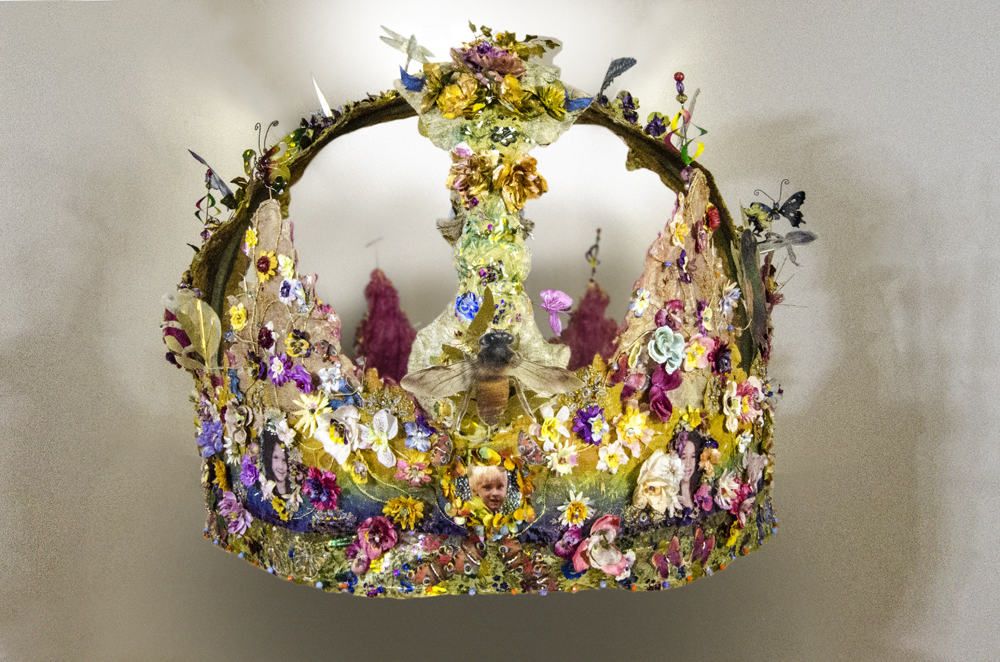 Jacqueline Treloar, Great Children’s Crown (Corona Magna Puerorum), 2013, detail, fabric and mixed media, 4 x 5 foot. Photo: Lumir Hladik. Courtesy of the artist.
Jacqueline Treloar, Great Children’s Crown (Corona Magna Puerorum), 2013, detail, fabric and mixed media, 4 x 5 foot. Photo: Lumir Hladik. Courtesy of the artist.
This is the kind of artist Jacqueline Treloar is. She strives to open up what has been closed in us. She is a diligent housekeeper of the Infinite, making sure her allotted panels of the doors of perception swing to and fro as smoothly as possible.
This is the kind of artist Treloar is. Which means she inhabits a more-or-less embattled, confrontational role. “It is not news, “writes poet Ann Lauterbach in her The Night Sky: Writings on the Poetics of Experience (Viking, 2005), “that we are in a dispiriting time, one of personal and political cynicism, of unproductive doubt” (p.190). In this age of the bureaucrat-artist, the committee-artist, the media-artist, the dogged sociologist-as-artist, Treloar is committedly, stubbornly, a visionary artist, unashamedly in thrall to the energies of the transcendental.
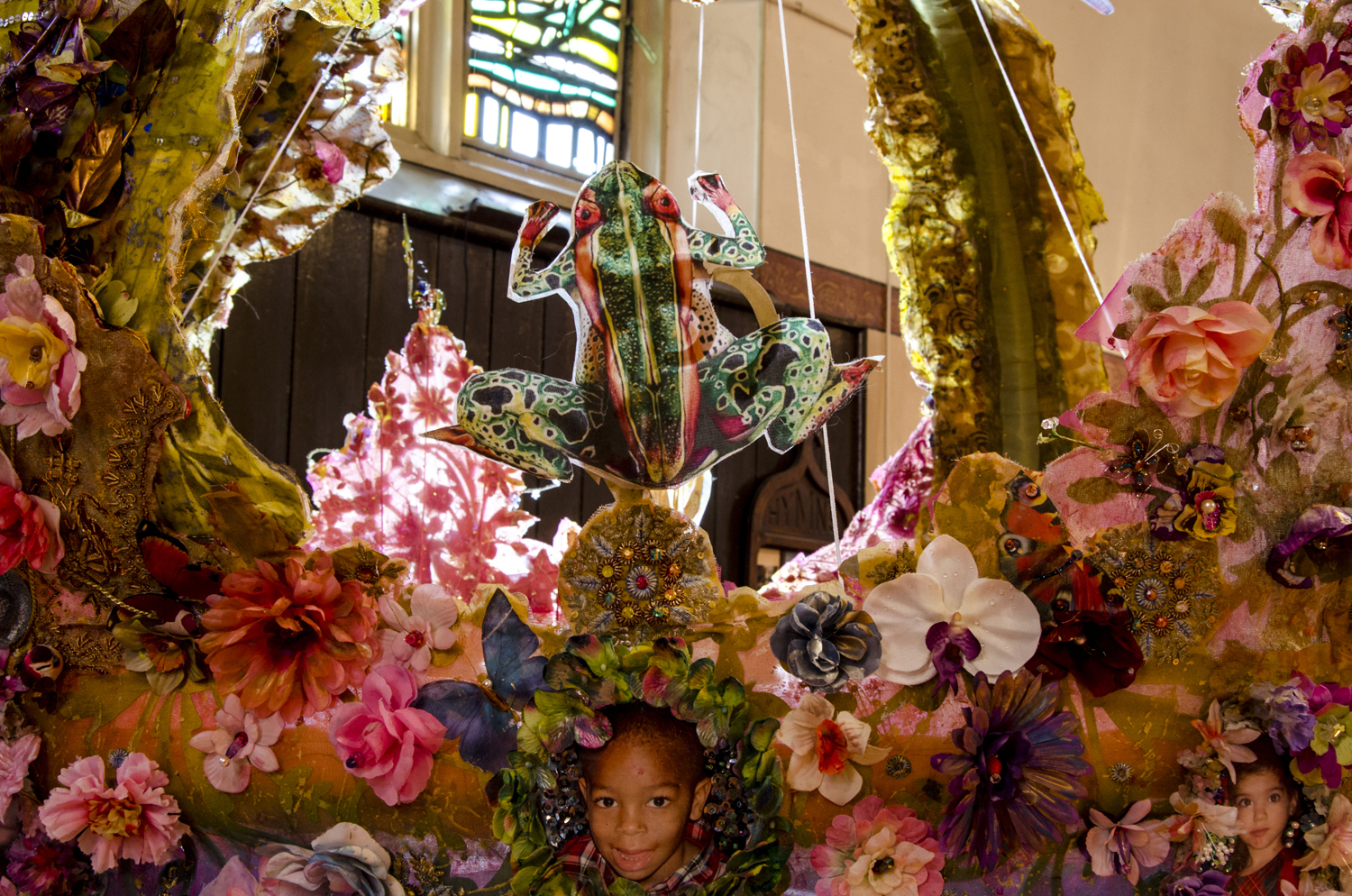 Jacqueline Treloar, Great Children’s Crown (Corona Magna Puerorum), 2013, detail with Jaden, fabric and mixed media, 4 x 5 foot. Photo: Lumir Hladik. Courtesy of the artist.
Jacqueline Treloar, Great Children’s Crown (Corona Magna Puerorum), 2013, detail with Jaden, fabric and mixed media, 4 x 5 foot. Photo: Lumir Hladik. Courtesy of the artist.
Her tools are desire, passion, memory, humility and reverence. She wields them with both tenderness and verve, valourizing, in her researches and constructions, in recourse to her jewels, beads, laces, swatches, toys, trinkets, tschotskes, photographs and assorted talismanic objects, what she refers to as “the implicit power in the people we care for and who, in so many ways, have changed our paths and whose presence has altered [us] and enabled us to go forward….”
Treloar pays attention, exquisite endless attention. She pays attention to history, to the arcing of the trajectory of humanist and devotional thought (those noble, august, crowned Madonnas, those elevated Marys) and she pays attention to our little (but not unimportant) places in that great—sometimes almost forgotten—hierarchical pageant. And, as Walter Benjamin noted in his essay, Some Reflections on Kafka (Schocken Books, 1968), “attention is the natural prayer of the soul.”
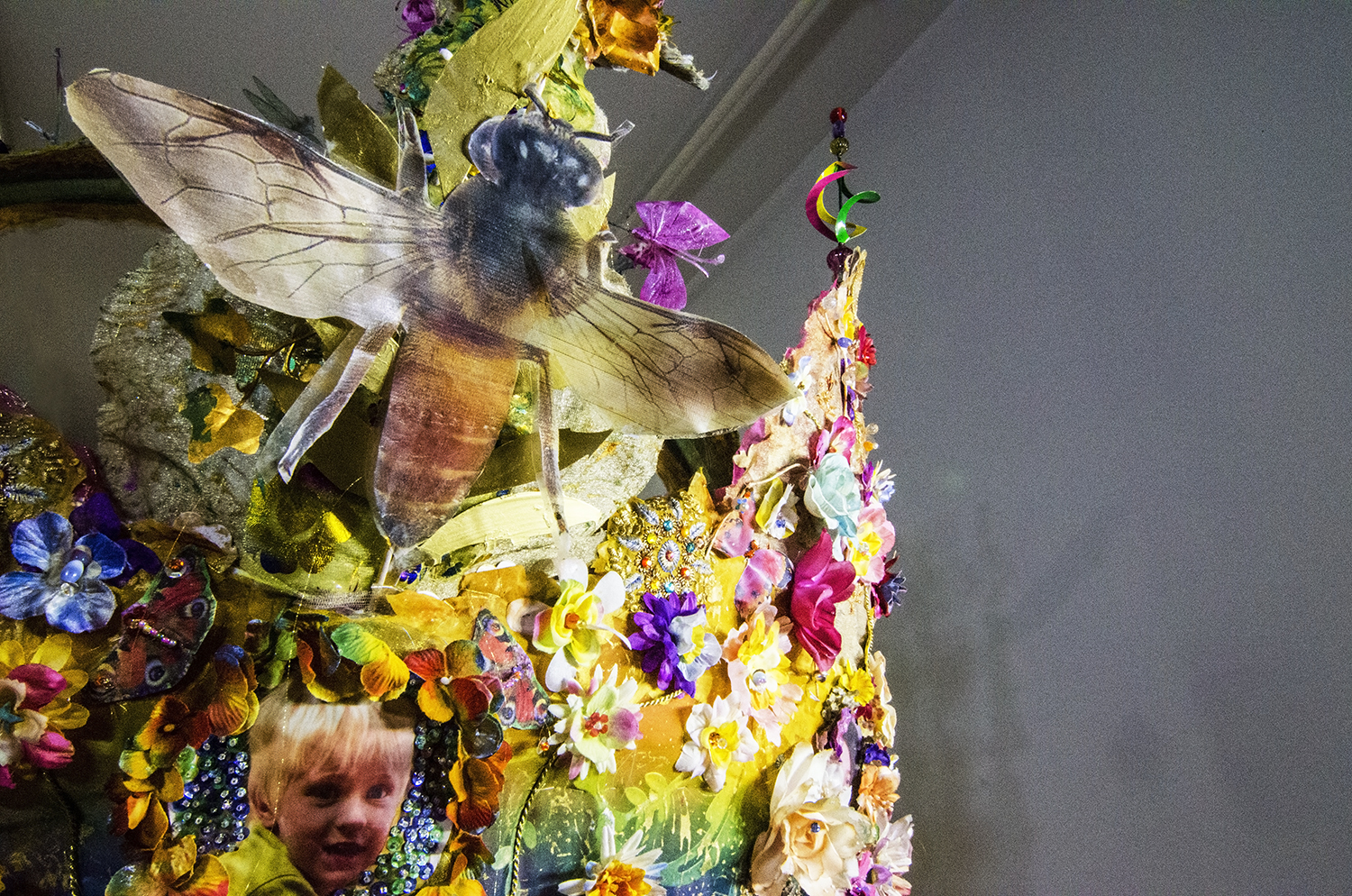 Jacqueline Treloar, Great Children’s Crown (Corona Magna Puerorum), 2013, detail with Conrad, fabric and mixed media, 4 x 5 foot. Photo: Lumir Hladik. Courtesy of the artist.
Jacqueline Treloar, Great Children’s Crown (Corona Magna Puerorum), 2013, detail with Conrad, fabric and mixed media, 4 x 5 foot. Photo: Lumir Hladik. Courtesy of the artist.
Treloar is, in her way, a lavish participant in the epic spirit, a modern-day Mnemosyne, the rememberer. She is a historian and enshriner (her Great Crowns are levitating shrines). Her works memorialize what needs to be memorialized. This is why her work is opulent but not extravagant (extravagance meaning—as “extra-vagant,” going outside of the lines, as it were).
It’s sort of silly, perhaps, but every time I gaze upon Treloar’s exquisite, hovering crowns, I think about a nest holding newborn birds (maybe “an exaltation of larks”), all of them lifting their open beaks upwards towards the light.
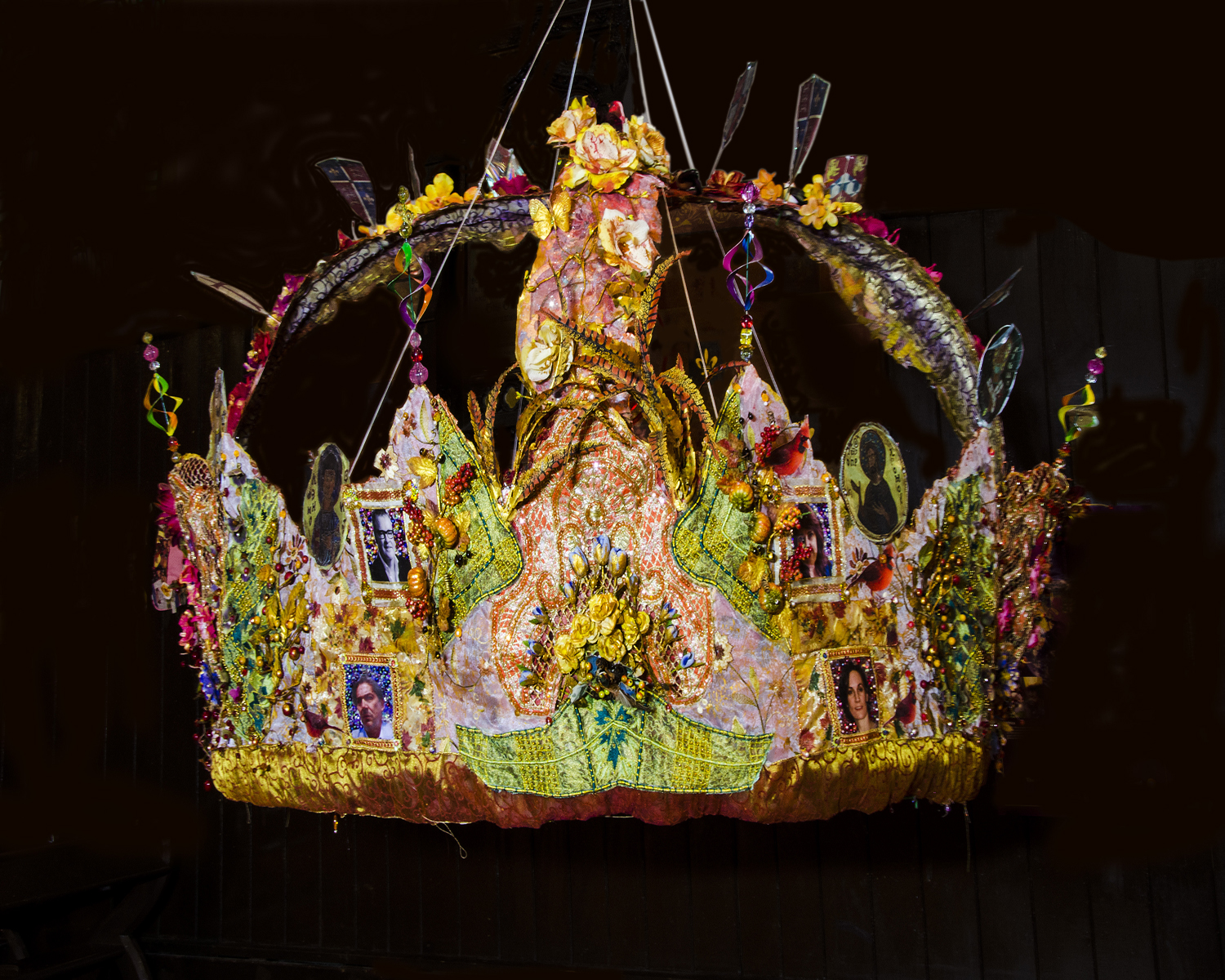 Jacqueline Treloar, Great Adult Crown (Corona Magna Adultorum), 2014, fabric and mixed media, 60 x 48 inches. Photo: Lumir Hladik. Courtesy of the artist.
Jacqueline Treloar, Great Adult Crown (Corona Magna Adultorum), 2014, fabric and mixed media, 60 x 48 inches. Photo: Lumir Hladik. Courtesy of the artist.
Crowns are ascentional objects. The Madonnas they evoke—as they generously evoke our own sublunary lives as well—live high above the earth: on thrones, hillsides, on a pillar (see the Virgin’s first century appearance on a pillar in Zaragoza, Spain, a visitation enshrined within the cathedral, the Nuestra Señora del Pilar (Our Lady of the Pillar), and honoured by the city’s annual flower offering, its Ofrenda de Flores, a mighty cloak of woven flowers for the Virgin).
The Virgin is The Lark Ascending.
I love the fact that Treloar’s majestic crowns are suspended in the air, held there by wires, dependent from wires (that is to say, sus-pended from wires, pendular, pendulum-like, hanging down). The paradox lurking for me in this depending, inhabits the fiction I have allowed myself that these acensional crowns may, if cut loose, if suddenly left without restraint, will rise, not fall. For me—and I insist on seeing it this way—the wires holding the crowns up are actually guy wires—holding them down.
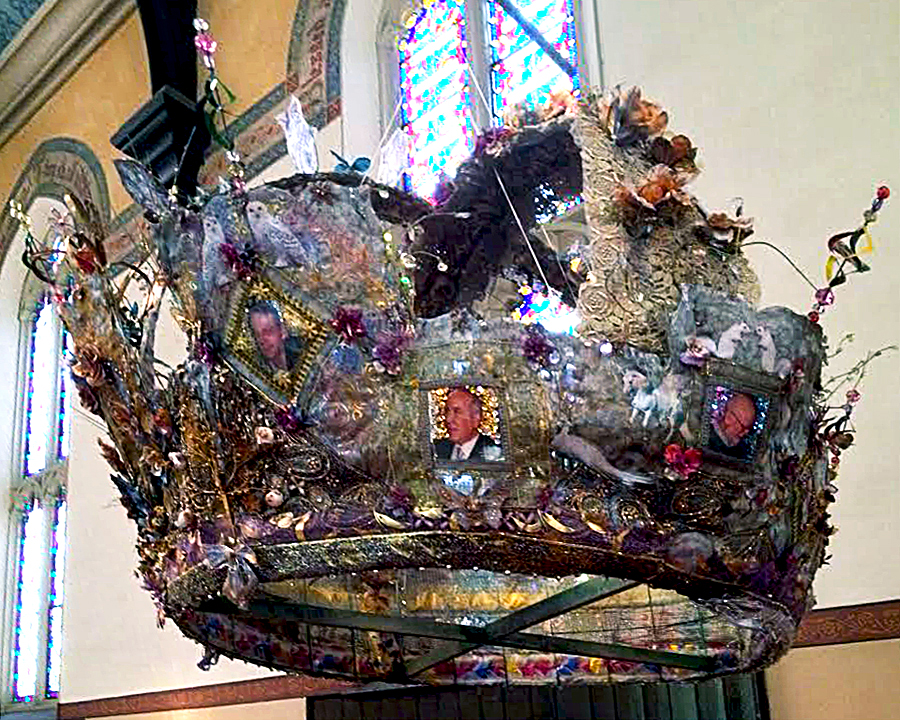 Jacqueline Treloar, Great Elder Crown (Corona Magna Senium), 2014, in the Holy Trinity Church, Toronto, mixed media, feathers and glass on nylon and plastic mesh base, 60 x 48 inches. Courtesy of the artist.
Jacqueline Treloar, Great Elder Crown (Corona Magna Senium), 2014, in the Holy Trinity Church, Toronto, mixed media, feathers and glass on nylon and plastic mesh base, 60 x 48 inches. Courtesy of the artist.
Treloar’s Madonna crowns are rising after Her.
It’s funny how affixed we remain (living on a sphere) to the idea that heaven (the site of The Good) is up, and hell (the residence of evil) is down. Maybe it’s all because of the structure of the human body, with the head—as the locus of perception and consciousness—at the top, and our ignoble feet way down below, at the bottom, in contact with the earth (as “feet of clay”). What is good, or what aspires to the good, rises (vectoring church steeples point up, birds fly up and away, our sensibilities yearn, when we are joyful—or hopeful—or aspiring) for upward mobility (one recalls Wordsworth’s soul leaving his body in delight, when confronted by a field of waving daffodils: “…and then my heart with pleasure fills / and dances with the daffodils….”).
 Jacqueline Treloar, The Great Children’s Crown (Corona Magna Puerorum), 2014, in the Holy Trinity Church, Toronto, fabric and mixed media, 60 x 48 inches. Photo: Lumir Hladik. Courtesy of the artist.
Jacqueline Treloar, The Great Children’s Crown (Corona Magna Puerorum), 2014, in the Holy Trinity Church, Toronto, fabric and mixed media, 60 x 48 inches. Photo: Lumir Hladik. Courtesy of the artist.
Treloar’s crowns are lush, lustrous, buoyant museums of iconographic plenitude. The whole world (local, global) is addressed somewhere within them, by accumulation or proliferation or by the artist’s generous, flowering will. When they are filled, they rise like the sun. A sun that never, however, sets.
Gary Michael Dault, May 15, 2014
*Exhibition information: Coronas Magnas Reginae Caeli by JACQUELINE TRELOAR, May 21 – August 15, 2014 at The Church of the Holy Trinity, 10 Trinity Square, Toronto. Hours: Mon – Fri 11 – 3, Sun 8 – 4 pm.

I was at this opening today and it was truly amazing. It is lovely to see how Jacquie’s work has grown and evolved over the years, yet a familiar thread runs through it. Seeing the work at eye level today gave you a chance to appreciate the scale and depth of detail these pieces have. Wonderful work … a must see!
…This Exhibition is precious, oversized, magnificent, expressing the genius of the artist as well as her humble side and respect for for the past and the present of human kind….an absolute must see!
Gabriele Craig
I went to Jacqueline’s show and talk yesterday, which showed the aesthetic value of an unconventional life. She seemed to me like Marco Polo, bringing back new ideas from her long trips in Spain and Sicily. It gave the same feeling of opening up that delighted so many people with Massimiliano Gioni’s curation at the VB – a pushing back and embracing of new ways of being an artist.
Jacqueline’s talk took me back to my university days studying Art History. Back then we didn’t have the artworks hanging before us, suspended and seemingly rising up to Heaven. Most of us will never see, know or understand Jacqueline’s inspirations in Italy and Spain: sculpture, Renaissance and Baroque painting and the symbol/culture of the Madonna, so entrenched in old world religion. Jacqueline’s crowns are new-world interpretations: they are not fashioned of precious metals and gemstones, but everyday objects that inhabit her world. In this way, she has created something uniquely her own, yet equally spectacular as it’s source material…